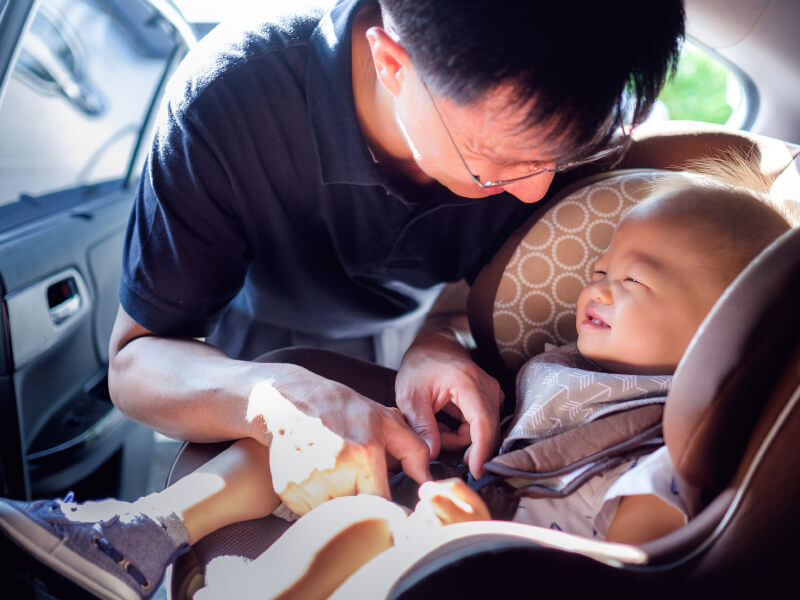Rev Up Your Car Seat Safety With These Tips
Babies and young children are precious beings, requiring our full care and attention at all times. At home, parents use protective devices such as cabinet locks and baby gates to keep their children safe and away from danger. In cars, parents use car seats and booster seats to keep children properly restrained and to prevent injuries in the event of sudden stops or crashes. Even though we may not be driving as much now due to closures and restrictions caused by the coronavirus, it is always great to refresh our minds with valuable car seat safety tips every time we take our children for a drive.
For parents who are using car seats for the first time, the National Highway Traffic Safety Administration (NHTSA) recommends following the instructions from the car seat manual for correct installation. For parents who would like a refresher on car seat safety, we suggest you call your state’s department of health and ask about their child safety seat programs. All states offer some sort of basic education to help with car seat selection for specific circumstances, assist with installation and provide general safety information. These state-sponsored car seat programs are free!
In Maryland, the Department of Health created a robust program, Kids in Safety Seats (KISS), to provide comprehensive car seat assistance and serve as a clearinghouse for parents and caregivers of educational information on car seat safety and installation. KISS also provides instruction to help people obtain national certification in Child Passenger Safety (CPS), a service of D.C.-based Safe Kids Worldwide. Those who receive national certification become CPS technicians who provide car seat inspections, installations and checks. The CPS certification serves as the gold standard for car seat safety and is taught and recognized globally.
According to KISS program coordinator Tracy Whitman, their CPS technicians review five main points when providing general assistance with car seats or inspections and installations.
- Car seat selection – The most appropriate car seat will depend on the child’s age, weight, height and any medical or behavioral issues.
- Direction in which the child will ride – Car seats may be rear-facing or forward-facing.
- The location of the car seat in the vehicle.
- Installation.
- The harness system – Most rear-facing car seats come with five-point harness systems.
Whitman emphasizes that KISS CPS technical services provide clear education and guidance during their discussions with parents and caregivers. For example, they may go into detail about the benefits of a car seat’s harness system, the correct positioning of a child’s body in a booster seat and other technical details depending on the child’s physical characteristics. In providing this type of straightforward information, KISS staff helps dispel car seat myths that previously left parents unsure of many details.
For example, several dangerous car seat myths that have made their rounds on social media include misconceptions that used or hand-me-down car seats are safe, expiration dates on car seats can be ignored and it’s okay to use car seats that have been in accidents. Factually correct information from the nationally certified CPS program leaves parents and caregivers more educated and confident in their knowledge of car seat safety and choices.
Another car seat guideline that frequently confuses parents is the decision of when to shift the positioning of a car seat from rear-facing to forward-facing.
Many jurisdictions including Virginia and D.C. offer general guidance to leave children rear-facing until at least the age of 2, but the state of Maryland and many car seat manufacturers take a more cautious approach, strongly encouraging parents to leave their child rear-facing for as long as biologically possible because children in rear-facing car seats experience less shock to the body in the event of a crash. A different way of putting this is to leave children in a rear-facing position until their height and weight reaches the maximum allowed dimensions of car seats. Once a child physically outgrows a rear-facing car seat, they are ready to be placed in a forward-facing car seat.
Similar height and weight issues exist for children in booster seats. Parents may be tempted to transition their forward-facing children to a booster seat, for example, but this may be problematic depending on the physical characteristics of the child. If a child is short and their feet are not able to reach the floor, they may not be ready to ride in a booster seat.
These are just a few of the many issues in car seat safety KISS is prepared to address. Parents may also ask about which is the best car seat to buy, how tethers and anchors work in the LATCH system or which car seat works best for adults with medical conditions such as arthritis. “As soon as parents start asking us specific questions, we start a dialogue,” notes Whitman.
Whitman recognizes parents and caregivers may have numerous questions, doubts or concerns. She is trained in the CPS program, trains her technicians and is fully prepared to help parents and caregivers through various creative communication methods, including email, regular phone calls, video seminars and chats, ZOOM calls (when initiated by parents) and even Skype calls. “It’s empowering to teach them,” notes Whitman enthusiastically, to help parents feel comfortable learning the ins and outs of their car seats.
During the pandemic, KISS has suspended in-person instruction and is offering car seat inspection and check-up classes via phone and video chats. During these 45-to-60-minute classes, CPS technicians teach parents and caregivers how to use and install car seats. KISS help is available five days a week and is ready to serve parents from the entire Washington, D.C. metropolitan area.
Further reading:
More information on Maryland’s KISS program
More information on Virginia’s car seat safety information
More information on D.C.’s car safety seat program
An overview of car seats and boosters provided by NHTSA

